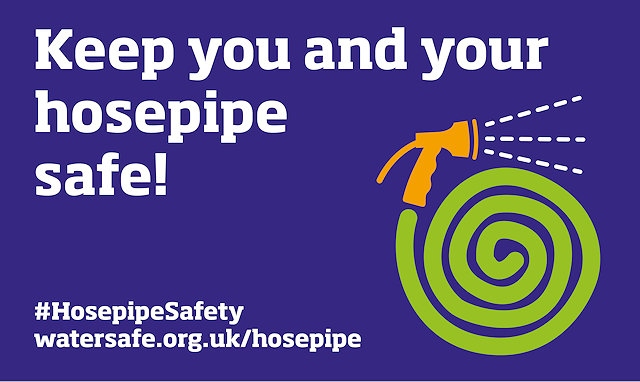Hosepipes and their hidden health risks – what every household should know
Date published: 25 June 2019

Lurking dangers in humble hosepipe prompt safety campaign
As much of the UK is set to bask in high temperatures, WaterSafe is alerting households in Greater Manchester about the potential health risks of using a garden hosepipe for watering and cooling off if simple safety measures aren’t followed.
The UK register of approved plumbers warns that hosepipes which are incorrectly fitted, or left submerged in places like ponds, watering cans or paddling pools, can cause illness.
This is because the dirty water can ‘backflow’ into the drinking water supply.
The best way to stay safe, and just as importantly save water in hot weather, is to swap the hosepipe for a watering can. However, for those using a hosepipe, WaterSafe has compiled a list of top tips, backed by The Royal Society for Public Health to keep households healthy.
- Fit an approved double check valve to hosepipes to prevent any water, or contaminants from the garden, ponds or paddling pools, flowing back into your mains drinking water supply.
- Don’t place hosepipes in drains, garden ponds, buckets or watering cans where they can be submerged as contaminated water could be siphoned back into your homes’ drinking water pipework.
- Turn off your hosepipe at the tap and ideally fully disconnect it when not in use.
- Fit a self-closing flow control, such as a trigger spray gun, to prevent it being used when unattended.
Hosepipes can become a breeding ground for potentially harmful bacteria including Legionella which thrives in warm, stagnant water. Aerosols (a very fine spray which cannot be seen by the human eye) are formed when the hosepipe is used and can be inhaled and lead to Legionnaires’ disease.
Whilst Legionnaires disease (a form of pneumonia) is rare, it can cause serious illness or even death particularly to the elderly or those with underlying illness. These simple steps will help to protect you:
- Keep your hose somewhere cool and out of the sun. Particularly, don’t use a hosepipe that has been sitting around and full of warm water to fill a hot tub. The warm water within the tub will allow bacteria – including Legionella and Pseduomonas aeruginosa (a bacteria which can cause a nasty itchy rash) – to quickly grow.
- Gently run the water out of the hose before you use it – without any form of spray attachment on the end.
Julie Spinks, Director of WaterSafe, said: “We’re encouraging everyone to follow these simple safety measures to not only help avoid contaminating your drinking water supply but also reduce the risk of contracting a serious illness.
“A WaterSafe approved plumber will be happy to help If you need help fitting an approved double check valve. They’re specially trained in the Water Fittings Regulations and Byelaws that help keep the UK’s drinking water safe.
“Better still, using a watering can instead of a hosepipe is much more water-efficient and won’t pose a risk to your drinking water supply.”
Do you have a story for us?
Let us know by emailing news@rochdaleonline.co.uk
All contact will be treated in confidence.
Most Viewed News Stories
- 1Royton haulage firm fined after Rochdale dad went to work and didn’t come home
- 2Six men arrested in Rochdale child exploitation investigation
- 3Newhey's Char Steakhouse and Bank Chamber close with immediate effect
- 4Two men arrested after police chase ends up in Middleton river
- 5Obituary: Jean Ashworth
To contact the Rochdale Online news desk, email news@rochdaleonline.co.uk or visit our news submission page.
To get the latest news on your desktop or mobile, follow Rochdale Online on Twitter and Facebook.


